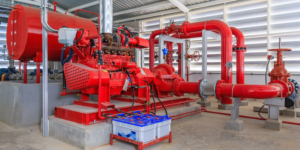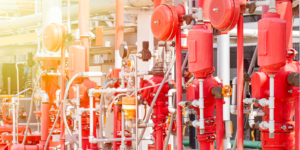Commercial properties need sprinkler systems to prevent fires. Whether you operate an office building, retail space, or industrial complex, sprinkler system benefits and maintenance are crucial. We’ll discuss sprinkler system types, present a step-by-step installation guide, offer maintenance advice to maximize performance and troubleshoot frequent difficulties.
Benefits of Installing Sprinkler Systems in Commercial Buildings
Protecting business buildings with sprinkler systems is smart. These systems provide many benefits that protect the structure and its people.
Installing sprinkler systems in business buildings helps identify and fight fires rapidly. Sprinklers activate automatically when they detect heat or smoke, responding quickly to fire dangers. Early discovery can drastically prevent fire spread and property damage.
Commercial building owners can also save money on insurance with a reliable sprinkler system. Properly maintained fire prevention systems reduce risk for insurance providers, resulting in lower premiums. This crucial fire protection feature provides peace of mind and practical advantages by decreasing property damage, occupant safety, and insurance costs.
Types of Sprinkler Systems
Sprinkler systems for commercial buildings come in many varieties. Different types serve different objectives and give different benefits. Learn about the different types to choose the correct system for your building.

- Wet pipe sprinkler systems are the most frequent in commercial structures. Water pipes and sprinklers make up its system. If heat activates a sprinkler, water rushes through the pipe to extinguish the fire.
- Dry Pipe Systems: Dry pipe systems do not contain water regularly. They contain pressurized air or nitrogen gas to store water until heat activates a sprinkler. In places where freezing temperatures might burst pipes, this technology is used.
- Pre-action Systems: These systems mix wet and dry pipe elements. Water cannot flow through pipes filled with compressed air or nitrogen gas until a smoke detector or heat sensor activates and one or more sprinklers are triggered by heat within 60 seconds.
- Deluge Systems: When actuated by user intervention or an alert signal from flame detectors or smoke sensors, all sprinklers on a floor or zone open at once.
Each type has pros and downsides depending on building occupancy, use case situations (data centers vs. warehouses), location concerns (electrical rooms), and emergency response times.
Step-by-Step Guide to Installing a Sprinkler System
While installing a sprinkler system in a business facility may seem daunting, it can be done with the appropriate advice. This step-by-step instruction will help you install it.
- Design and Planning: Assess your building’s layout and determine fire protection needs. Plan pipe routing, valve placement, and sprinkler head locations.
- Gather Materials: Once you have a plan, gather pipes, fittings, valves, sprinkler heads, and any other installation equipment.
- Prepare the Area: Remove any impediments or debris before installing. It will streamline installation.
- Install Pipes and Fittings: Install the main water supply line and branch lines to each building zone. Use fittings according to your design plan to connect pipes.
- put sprinkler heads: After pipes are built, put sprinkler heads in places that meet fire protection criteria for each building area.
- Connect Valves and Test System: After mounting sprinkler heads, connect valves to control water flow into system zones. Before continuing, test each zone for functionality.
- Finish Connections: Local fire safety requirements for commercial buildings require pressure gauges and flow controls to be connected.
- System Inspection: Qualified personnel must inspect your freshly installed system to ensure compliance with industry standards and optimal performance.
This article solely covers installing a sprinkler system in commercial buildings; skilled fire protection system installers are recommended for a successful installation.
Maintenance Tips for Sprinkler Systems
To ensure the longevity and effectiveness of your sprinkler system, regular maintenance is key. Here are some essential tips to keep in mind:
1. Inspect regularly: Regular inspections can help identify any issues or potential problems before they escalate. Check for leaks, damaged pipes, and obstructions around the sprinklers.
2. Test the system: Periodically test your sprinkler system by activating it manually or using a timer. This will help you identify any malfunctioning parts or areas that may not be receiving adequate water coverage.
3. Clean the nozzles: Over time, debris can accumulate in the nozzles, leading to reduced water flow and uneven distribution. Clean the nozzles regularly to ensure optimal performance.

4. Adjust spray patterns: As plants grow and landscaping changes, it’s important to adjust the spray patterns accordingly to avoid overwatering or under-watering certain areas.
5. Winterize properly: Before winter arrives, make sure you properly winterize your sprinkler system by draining all water from pipes and shutting off valves to prevent freezing damage.
6. Hire professionals when needed: For more complex tasks such as valve repairs or pipe replacements, it’s best to hire experienced professionals who have expertise in handling sprinkler systems.
By following these maintenance tips, you can extend the lifespan of your commercial building’s sprinkler system and ensure it operates efficiently all year round without any major issues!
Common Issues with Sprinkler Systems and How to Troubleshoot
Sprinkler systems are crucial to commercial fire protection. However, like any mechanical system, they might malfunction. Knowing common issues and how to fix them might help your sprinkler system work better. Sprinkler pipe or fitting leaks are typical. These leaks might lower water pressure or cause system failure. Regularly check sprinklers for water damage or pooling to fix this issue. It’s vital to fix or replace leaky components immediately.
Corrosion reduces water flow and system functionality. Regular maintenance should involve examining pipes’ internal and external surfaces for rust or degeneration. Corrosion requires a professional evaluation to determine repairs or replacements.
Another prevalent issue for building owners and managers is clogged nozzles. Dust, grime, and insects can build up inside nozzles and impede emergency water distribution. Clogs can be avoided by regularly cleaning and inspecting all building nozzles.
Electrical difficulties can affect sprinkler performance and reliability. During a fire, control panels and sprinklers may not communicate due to wiring issues or power outages. Test your system’s electrical components during routine maintenance to spot issues before they become critical.
Staying aware of these frequent sprinkler system faults and taking proactive troubleshooting steps will help you keep your commercial property’s fire prevention solution running well!
